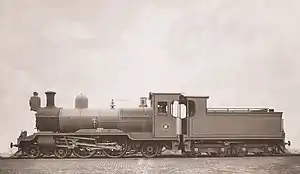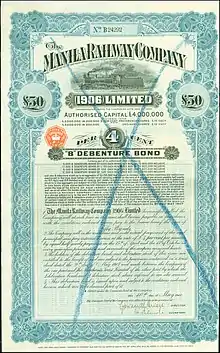Manila Railway 100 class
The Manila Railway 100 class[2] of 1906 were five 4-4-2 Atlantic-type steam locomotives built by the North British Locomotive Company. They were the flagship locomotives of the Manila Railway during the late 1900s and throughout the 1910s, being the first tender-hauling locomotives in Philippine service. They hauled the Baguio Special, an express service between Manila and Baguio via Damortis station in Rosario, La Union.[3]
| Manila Railway 100 class | |||||||||||||||||||||||||||||||||||||||||||||||
|---|---|---|---|---|---|---|---|---|---|---|---|---|---|---|---|---|---|---|---|---|---|---|---|---|---|---|---|---|---|---|---|---|---|---|---|---|---|---|---|---|---|---|---|---|---|---|---|
 Manila Railway 101 in Scotland. | |||||||||||||||||||||||||||||||||||||||||||||||
| |||||||||||||||||||||||||||||||||||||||||||||||
| |||||||||||||||||||||||||||||||||||||||||||||||
| |||||||||||||||||||||||||||||||||||||||||||||||
| |||||||||||||||||||||||||||||||||||||||||||||||
| References:[1][2] | |||||||||||||||||||||||||||||||||||||||||||||||
The locomotives were relegated to freight services in the 1920s, hauling sugarcane trains in Central Luzon until they were scrapped.[4]
Background
The Manila Railway Company, ancestor of the Philippine National Railways, operated solely tank locomotives on the Ferrocarril de Manila a Dagupan (now the North Main Line) through much of its early history. These locomotives burned wood fuel instead of using coal. Horace L. Higgins, a British engineer who was the head of the Manila Railway, ordered the modernization of its entire fleet. This would include the acquisition of bigger locomotives of the 40–45 t (88,000–99,000 lb) range and purchase of heavier track.[5]
Neilson and Company and Dübs and Company, builders of the preceding Dagupan class, merged with another Glasgow-based manufacturer to form the North British Locomotive Company during this period.[6] The Manila Railway then approached the newly formed manufacturer to build what would become the 100 class, as well as a series of tank locomotives named the 70 class.[7]
Design
Having entered in 1906, the 100 class was the first tender-hauling steam locomotive in the Philippines. It used the 4-4-2 Atlantic wheel arrangement, which was a popular among express trains during the 1900s.
The design of the locomotives were built to Higgins' expectations in mind, especially to its weight.[5] Weighing 41 metric tons (40 long tons) with the locomotive alone, it weighed heavier by 28 percent than its predecessors which normally weighed at 32 metric tons (31 LT). The locomotive overall weighed 73 metric tons (72 LT) with its four-axle tender.[1]
Its most notable feature is the use of a cab for both the locomotive and the tender. This cab design would later influence the 2-8-0 Consolidation-type 130 class of 1912[8] and the first batch of the 4-6-0 Ten-wheeler-type Manila Railroad 45 class of 1919.[9] Both of these succeeding designs were tender locomotives.
Service

The 100 class was promoted as the flagship locomotive of the Manila Railway during their introduction in the late 1900s. They appeared on various advertisements for the Baguio Special, a mixed train-bus service between Manila and Baguio via Damortis station in Rosario, La Union. This was then the flagship service of the company on the North Main Line and carried tourists between the two cities in nine hours, with an average speed of 30 kilometers per hour (19 mph).[10] It also appeared on the header of the Manila Railway's bond documents.
Retirement
As later stated by The Locomotive Magazine, the locomotives had their brief heyday as the premiere express train locomotives, a fate shared by other locomotives of the same wheel type.[1] By 1916, the Insular Government acquired the Manila Railway and merged into the New Jersey-based Manila Railroad Company. Henry Bayard McCoy, a United States Army colonel[11] and a member of the Republican National Committee for the Philippines,[12] replaced Higgins as general manager. The new administration ushered the acquisition of more powerful locomotives from the United States. These new locomotives started entering service by 1919 and have largely replaced the aging British locomotives in mainline service for the next decades.[13]
The Baguio Special[14] and the newly inaugurated Bicol Express between Manila and Quezon province has then been hauled by the newly acquired Manila Railroad 45 class.[15] Since 1922, the 100 and 120 classes were transferred to freight trains carrying sugarcane.[4]
It remains unknown when the 100 class were retired and scrapped. The arrival of Vulcan Iron Works, Pennsylvania-built 4-8-2 Mountain-type Manila Railroad 100 class in 1948 suggests that the original 4-4-2 Manila Railway 100 class had been out of service with the Manila Railroad. No locomotives survive today as with all tender locomotives in service with the two companies.[16]
References
- Llanso, Steve. "Manila Railroad 4-4-2 Locomotives in [the] Philippines". SteamLocomotive.com. Sweat House Media. Retrieved January 18, 2021.
- "New Locomotives, Manila Railway". The Locomotive Magazine. Vol. XIV. May 15, 1909.
- "Baguio Special at Manila Station ca 1911". Far Eastern Review. 1912. Retrieved January 14, 2021. (registration required)
- "Manila RR Sugar Cane train - 1922". Flickr. December 31, 1922. Retrieved January 20, 2021. (registration required)
- Sartre, Gary. "The Cagayan Valley Railway Extension Project". Japan Railway & Transport Review. No. 22.
- "Dubs and Co". Grace's Guide to British Industrial Heritage.
- Llanso, Steve. "Manila Railroad 0-6-2 Locomotives in [the] Philippines". SteamLocomotive.com. Sweat House Media. Retrieved January 20, 2021.
- Moreno Jerez, Luis (1917). "The Nationalization of the Philippine Railroads". The Philippine Review. p. 259. Retrieved January 19, 2021. (registration required)
- "Manila RR 4-6-0 (Porter) Locomotive - 1922". Flickr. Retrieved January 19, 2021. (registration required)
- "Ad for the Manila Railroad Co. - 1912". Far Eastern Review. September 1912. Retrieved January 19, 2021. (registration required)
- "USN 900555 Colonel Henry Bayard McCoy Memorial". Naval History and Heritage Command. United States Navy. Retrieved January 30, 2021.
- McCoy. Library of Congress. June 1, 1916. Retrieved January 30, 2021.
- Wright, Roy (1922). Locomotive Cyclopedia of American Practice, Sixth Edition. New York City: Simmons-Boardman.
- "Manila Railroad Co. service from Manila to Baguio". Flickr. Retrieved January 20, 2021. (registration required)
- "Bicol Express leaving Paco Station, Manila ca 1920". Flickr. Retrieved January 20, 2021. (registration required)
- Bayan, Sergio (1949). "1949 Report of the General Manager". Reports of the General Manager, Manila Railroad Company. 31.